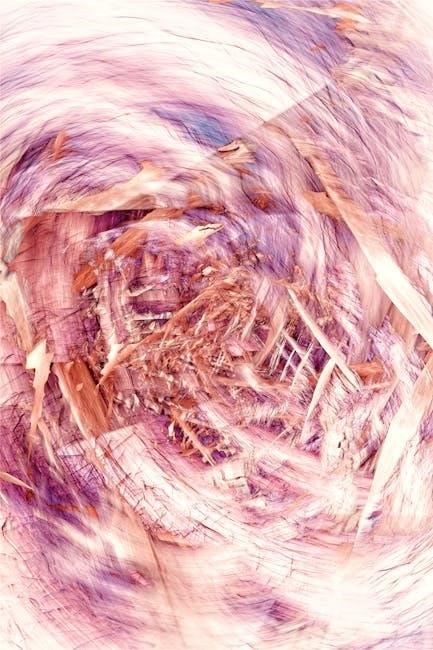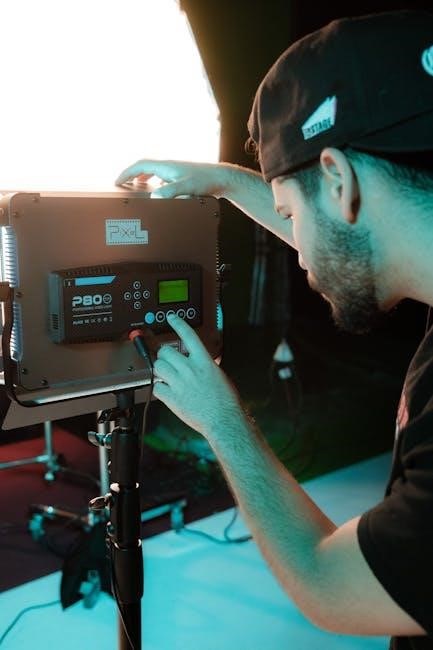
production possibilities curve worksheet pdf answer key
The Production Possibilities Curve (PPC) is a graphical model illustrating resource allocation and scarcity. It demonstrates trade-offs in producing goods/services, enabling analysis of economic efficiency and opportunity costs.
1.1 Definition and Purpose
The Production Possibilities Curve (PPC) is a graphical representation of the maximum output combinations of two goods or services an economy can produce. It illustrates the trade-offs between producing one good over another due to limited resources. The PPC serves as a foundational tool in economics to visualize scarcity, opportunity cost, and efficient resource allocation. By analyzing the curve, economists can identify optimal production levels and understand the consequences of resource constraints.
1.2 Importance in Economics
The Production Possibilities Curve (PPC) is a cornerstone of economic analysis, illustrating the fundamental concept of scarcity and the trade-offs inherent in resource allocation. It helps economists and policymakers understand the limits of production, opportunity costs, and efficient resource use. By analyzing the PPC, decision-makers can identify optimal production levels, evaluate the impact of resource constraints, and develop strategies to maximize economic efficiency. This tool is essential for teaching and applying core economic principles in real-world scenarios.

Understanding the Production Possibilities Curve
The PPC graphically represents an economy’s maximum production combinations of two goods, highlighting trade-offs and efficiency. It serves as a foundational tool for analyzing economic production decisions.
2.1 What is the PPC?
The Production Possibilities Curve (PPC) is a graphical representation of the maximum quantities of two goods an economy can produce with its available resources. It illustrates the trade-offs between producing one good over another, assuming resources are fully employed and technology is constant. The PPC serves as a tool to visualize scarcity, opportunity cost, and efficiency in production. It is a fundamental concept in economics, often used to analyze how societies allocate resources and make decisions about production.
2.2 Shape of the PPC
The Production Possibilities Curve (PPC) is typically concave, or bowed outward, due to the law of increasing opportunity costs. As resources are redirected to produce more of one good, the cost of producing each additional unit rises because resources are not perfectly adaptable. This concave shape reflects the trade-offs and inefficiencies inherent in resource allocation. The curve’s slope becomes steeper as production shifts toward more of one good, indicating the increasing sacrifices required to produce additional units.
2.3 Axes of the PPC
The axes of the Production Possibilities Curve (PPC) represent the maximum quantities of two goods or services an economy can produce. Typically, one axis measures the production of consumer goods, while the other measures capital goods. These axes are quantitative, showing the trade-offs between producing one good over another. The axes are based on the assumption of full employment of resources and reflect the economy’s technological constraints. They do not represent monetary values or consumer satisfaction, only physical production levels.
Key Concepts Related to the PPC
The PPC introduces core economic concepts like opportunity cost, scarcity, and efficiency. These ideas help understand trade-offs in resource allocation and production decisions.
3.1 Opportunity Cost
Opportunity cost is the value of the next best alternative sacrificed when choosing to produce one good over another. It is a fundamental concept in economics, representing the trade-offs inherent in resource allocation. Graphically, the slope of the PPC reflects opportunity cost, showing how resources must shift between producing different goods. Understanding opportunity cost helps in making efficient production decisions and analyzing the economic implications of resource utilization. It is essential for evaluating the benefits and drawbacks of various production strategies.
3.2 Increasing Opportunity Cost
Increasing opportunity cost occurs as production shifts from one good to another. The PPC’s slope becomes steeper, reflecting higher costs. Producing more of one good requires sacrificing increasing amounts of another, due to resource specialization. This concept explains why societies face trade-offs and highlights the scarcity of resources. The law of increasing opportunity cost shapes the convex shape of the PPC, emphasizing economic efficiency and the limitations of resource allocation. It is a critical principle in understanding production decisions.
3.3 Scarcity and Trade-offs
Scarcity and trade-offs are central concepts in economics, illustrated by the PPC. Scarcity arises because unlimited wants exceed limited resources, forcing societies to make choices. The PPC shows the maximum combinations of goods an economy can produce, highlighting trade-offs. As resources are allocated to produce more of one good, less of another can be produced, reflecting opportunity costs. This scarcity-trade-off relationship underscores the need for efficient resource allocation to meet societal demands effectively.
Analyzing the Production Possibilities Curve
Analyzing the PPC involves interpreting points to understand production limits, calculating opportunity costs, and evaluating trade-offs. It helps assess economic efficiency and resource allocation decisions graphically.
4.1 Interpreting Points on the PPC
Interpreting points on the PPC involves understanding production combinations. Points on the curve represent maximum output mixes, while points inside indicate underutilized resources. Points beyond the curve are unattainable. By plotting specific values, students analyze trade-offs and efficiency, enhancing their grasp of economic constraints and opportunity costs through practical exercises, as seen in worksheets and answer keys focusing on PPC analysis.
4.2 Calculating Opportunity Costs
Calculating opportunity costs involves comparing production levels before and after allocating resources. For instance, if producing one more unit of Good A results in sacrificing three units of Good B, the opportunity cost is three units of B. This is determined by analyzing shifts along the PPC, providing insights into trade-offs and resource allocation efficiency. Worksheets often include tables to simplify these calculations, helping students grasp the practical application of opportunity costs in economic decision-making.

Shifts in the Production Possibilities Curve
Shifts in the PPC occur due to changes in resources, technology, or inefficiency. An outward shift indicates increased production capacity, while an inward shift reflects reduced resources or inefficiency.
5.1 Factors Causing Shifts
Shifts in the PPC are triggered by various factors, including changes in resource availability, technological advancements, and economic inefficiencies. For instance, increased labor or capital can shift the curve outward, enabling higher production. Conversely, natural disasters or resource depletion can cause inward shifts, limiting output. Additionally, technological progress enhances efficiency, allowing more goods to be produced with the same resources. These factors collectively influence the economy’s productive capacity over time.
5.2 Effects of Shifts on Production
Shifts in the PPC significantly impact production capabilities. An outward shift increases output potential, reflecting economic growth or improved efficiency. This occurs due to technological advancements or increased resources. Conversely, inward shifts reduce production capacity, often caused by resource depletion or economic downturns. These changes alter the trade-offs between goods, influencing economic performance and resource allocation decisions. Understanding these effects is crucial for analyzing how economies adapt to internal and external changes over time.
Allocative Efficiency and the PPC
Allocative efficiency occurs when resources are allocated to meet consumer preferences, maximizing satisfaction. The PPC helps identify this by showing optimal combinations of goods/services, ensuring resources are used effectively.
6.1 Achieving Allocative Efficiency
Allocative efficiency is achieved when an economy produces goods/services in line with consumer preferences. The PPC identifies optimal production points, ensuring resources are allocated to maximize societal welfare. This occurs where marginal benefits equal marginal costs, reflecting efficient resource use. By analyzing the PPC, economists determine the best output mix, balancing trade-offs and ensuring satisfaction of societal demands without wastage. This concept is crucial for sustainable economic growth and development, addressing scarcity effectively.
6.2 Consequences of Inefficiency
Inefficient production, represented by points inside the PPC, indicates underutilized resources or poor allocation. This results in missed opportunities for optimal output, leading to reduced economic performance. Over time, inefficiency can hinder growth, reduce competitiveness, and lower societal welfare. Addressing inefficiency requires identifying and reallocating resources effectively, ensuring production aligns with the PPC to maximize output and satisfaction. Sustained inefficiency can negatively impact long-term economic health and innovation capabilities;

Worksheet Exercises and Answer Key
Practice exercises involve graphing PPCs, calculating opportunity costs, and interpreting shifts. Answer keys provide solutions, ensuring understanding of resource allocation and trade-offs in economics.
7.1 Graphing the PPC
Graphing the PPC involves plotting maximum production combinations of two goods/services. Use data tables to identify points, label axes, and draw the curve. Ensure accuracy by plotting intercepts and connecting points smoothly. The slope reflects opportunity costs. Answer keys verify correct graphing, ensuring understanding of resource allocation and scarcity concepts. Common errors include mislabeling axes or miscalculating maximum outputs. Practice exercises reinforce PPC interpretation skills, essential for analyzing economic trade-offs and efficiency.
7.2 Solving for Opportunity Costs
Solving for opportunity costs involves calculating trade-offs between producing one good over another. Use PPC data to determine costs by comparing production levels. For example, moving from producing 10 units of Good A to 15 units may require sacrificing 5 units of Good B. Answer keys provide step-by-step solutions, ensuring accurate calculations. Understanding opportunity costs helps analyze economic decisions and resource allocation. Practice exercises reinforce concepts, enabling precise interpretation of production trade-offs and their economic implications.
7.3 Interpreting Shifts in the PPC

Interpreting shifts in the PPC involves analyzing changes in production capabilities. An outward shift indicates increased output due to factors like technological advancements or increased resources. An inward shift reflects decreased production, often from reduced resources or inefficiencies. Answer keys guide students in identifying causes of shifts, such as economic growth or downturns. Exercises help interpret graphical movements, linking them to real-world economic scenarios and enhancing understanding of how external factors impact production potential.
Common Mistakes and Solutions
Common mistakes include misinterpreting the PPC slope and miscalculating opportunity costs. Solutions involve careful graph analysis and understanding economic trade-offs to avoid errors in production decisions.
8.1 Misinterpretation of the PPC
A common mistake is misunderstanding the PPC as a tool for consumer satisfaction rather than production limits. Many misinterpret the curve’s slope, thinking it represents consumer preferences rather than opportunity costs. Additionally, some incorrectly assume the PPC is a straight line or fails to recognize increasing opportunity costs. These errors lead to flawed conclusions about trade-offs and resource allocation. Reviewing graphical analysis and economic principles, as outlined in resources like StudyLib and Quizlet, can clarify such misconceptions and improve understanding of production decisions.
8.2 Calculation Errors
Common calculation errors include miscomputing opportunity costs by dividing rather than subtracting points on the PPC. Students often mislabel axes or incorrectly interpret the slope, leading to wrong conclusions about trade-offs. Additionally, miscalculating the difference between production points can result in inaccurate opportunity cost ratios. To avoid these errors, carefully follow graphing instructions and double-check calculations. Resources like StudyLib and Quizlet offer practice exercises to improve accuracy and understanding of PPC analysis.
The PPC worksheet helps master key economic concepts like opportunity costs and resource allocation. Practical applications of these principles guide real-world decision-making and economic analysis effectively.
9.1 Summary of Key Takeaways
The Production Possibilities Curve (PPC) is a cornerstone of economics, illustrating the trade-offs in resource allocation. It highlights opportunity costs, scarcity, and efficiency. By analyzing the PPC, we understand how economies maximize output and make decisions about what to produce. Key concepts include the curve’s shape, opportunity cost calculations, and shifts in production possibilities. These principles are essential for grasping economic decision-making and resource management. Worksheets and exercises provide practical tools for mastering these foundational ideas.
9.2 Practical Applications
The PPC is a vital tool for understanding real-world economic decisions. It helps governments and businesses allocate resources efficiently, balancing production priorities. Worksheets and exercises, like those in the answer key, enable students to apply PPC concepts to scenarios such as trade-offs between defense and food production. This model also aids in analyzing the impacts of scarcity and opportunity costs in international trade and policy-making, making it a practical framework for economic planning and decision-making at various levels.

Additional Resources
Explore study guides and online tutorials for in-depth PPC analysis. Utilize practice worksheets with answer keys to master graphing and interpreting production possibilities curves effectively.
10.1 Recommended Reading
For a deeper understanding, explore textbooks like “Economics: Principles, Problems, and Policies” by McConnell. Visit studylib.net for PPC worksheets and guides. Utilize Quizlet flashcards for key terms and concepts. Additionally, refer to Khan Academy and Coursera courses for interactive learning. These resources provide comprehensive coverage of PPC theory, graphing techniques, and practical exercises to enhance your skills in analyzing production possibilities curves effectively.
10.2 Online Tools and Tutorials
Enhance your understanding with online tools like Graphing Calculator for interactive PPC graphs. Platforms such as Khan Academy and Coursera offer video tutorials. Use StudyLib for worksheet solutions. Tools like Quizlet provide flashcards for key terms. These resources help visualize PPC concepts, calculate opportunity costs, and interpret shifts, making learning engaging and effective.